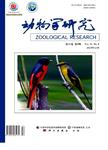Micromorphology and Maturation of the Yellow Granules in the Hornet Gastral Cuticle
黄蜂胃部表皮黄色颗粒的微观形态与发育(英文)作者机构:Department of Physiology and Pharmacology Sackler Faculty of Medicine Tel-Aviv University Wolfson Applied Materials Research Center Tel-Aviv University School of Physics and Astronomy Raymond and Beverly Sackler Faculty of Exact Sciences Tel-Aviv University
出 版 物:《Zoological Research》 (动物学研究(英文))
年 卷 期:2009年第30卷第1期
页 面:65-73页
核心收录:
学科分类:0710[理学-生物学] 07[理学] 09[农学]
主 题:Micromorphology Cuticle Yellow granules Peripheral photoreceptor Oriental hornet Vespa orientalis
摘 要:The yellow granules in the gastral cuticle of the Oriental hornet Vespa oriental& (Hymenoptera, Vespinae) are located in yellow stripes. In the present study, we focus on the micromorphology and formation of the yellow granules from their inception to their spread in the regions which are destined to acquire a yellow color, The cuticle was observed with several methods of electron microscopy. The results showed that the yellow granules comprise a layer which is 20-25 μm thick, within the total cuticular thickness of 40-45 μm. In the mentioned regions one can see, from above, many apertures of about 0.5μm in diameter which extends into a peripheral photoreceptor cell. In each yellow granule, one discerns a myoid envelope inside which there are 9 fibrils arranged in a circle. Yellow granules maturation process involves infiltration of canals that give rise to the incipient ball-shaped primary granules which increase in number (as a result of continues budding off the walls of a canal) as the cuticle matures and transform into secondary barrel shaped granules, becoming elongated and then splitting into shorter barrels that fill up the entire area. Preliminary examinations have suggested liver-like function activity within the layer of yellow granules.



